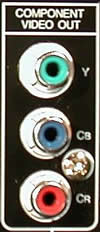|
Component
video /RGB /YUV (Very good  ) )
Finally, component is rarely seen on DVD players but
will start to appear with increasing regularity as projection
systems and Plasma become more popular. Basically, the picture
is spilt to it's component parts and passed via three different
connectors to the TV/Projector. Component can only be used
when there is a dedicated component input on the TV/Projector.
-
Labelled as: Either
RGB or YUV, YPbPr, YCbCr or Y/B-Y/R-Y.
-
Some U.S. and Japanese
players output interlaced component YUV
video via 3 Phono or BNC connectors
-
European players usually
provide RGB via scart or 3 Phono.
-
80% of European TV may
lose control of colour saturation.
-
Note: RGB (European)
and YUV (US) are non-compatible variants of component
video. A transcoder is needed to link up the YUV player
and RGB equipment.
DVD stores a component video signal in
digital format. Since this is the native video format that
is stored on DVD, this is also the best format to use to
display the picture, if your equipment is capable of dealing
with this type of signal. In Australia, virtually no equipment
exists that is compatible with a component signal, though
there is some that is compatible with an RGB signal. Many
DVD players are capable of converting their native component
signal to an RGB signal, but this varies on a player-by-player
basis.
Problems with the Component signal
As discussed above, DVD stores its video
information in the component form, but unfortunately the
great majority of us cannot take advantage of this format.
The designers of the DVD format anticipated this, and made
allowances for it in the specification. All DVD players
are capable of downconverting a component video signal into
a more suitable format for display on the current generation
of consumer display devices. The first such downconversion
step is to S-Video, which is a connector that will
always be found on any DVD player.
What comes out of a TV camera?
A TV camera outputs a video
signal that is split into the three primary colours; red, green and
blue (RGB). The
entire colour spectrum can be represented by varying intensities
of these three colours. This signal needs to be modified
before it can be further processed or broadcast. Why?
Problems with the RGB signal
 The RGB signal has two
specific problems associated with it in the professional
video world. Firstly, it has a very high bandwidth. Secondly,
the colour and the black and white picture information are
combined within the RGB signal. This is dealt with in the
professional video world by converting the RGB signal into
a component signal, also referred to as a YPbPr
or YCbCr signal. The Y component of this signal
is the black and white information contained within the
original RGB signal. The Pb and Pr signals
are colour difference signals, which are mathematically
derived from the original RGB signal. For our purposes,
it is sufficient to understand that the Y signal
contains full bandwidth black and white picture information,
and the colour difference signals contain bandwidth reduced
colour information. It is important to realize
that component video output and RGB video
output are not the same and are not directly compatible
with each other, however, they are easily converted either
way using a transcoder.
|
|
|
|
